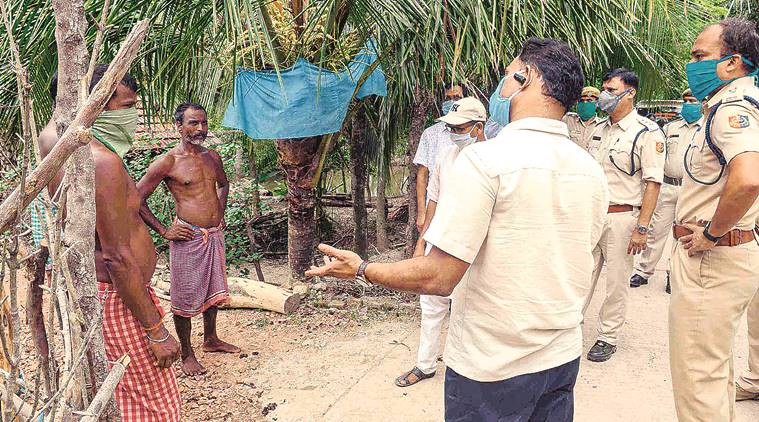 Government officials alert villagers ahead of the landfall of cyclone ‘Amphan’, in South 24 Parganas, Tuesday. (Photo: PTI)
Government officials alert villagers ahead of the landfall of cyclone ‘Amphan’, in South 24 Parganas, Tuesday. (Photo: PTI)
West Bengal scrambled to evacuate around 3 lakh people from coastal and low-lying areas to shelters as Cyclone Amphan — moving at a speed of 18 km/hr — is expected to make landfall between West Bengal’s Digha and Hatiya islands in Bangladesh on Wednesday and push up the sea level.
Indian meteorological officials said Cyclone Amphan, which has now weakened from Super Cyclone to an Extremely Severe Cyclonic Storm, will have a wind speed ranging between 155–165 km/hr when it makes landfall on Wednesday.
Chief Minister Mamata Banerjee said: “All precautionary measures are being taken… I had a word with Union Home Minister Amit Shah… At least 3 lakh people have been evacuated from three coastal districts of the state and moved to relief shelters.”
Banerjee said she will ask the ministry not to run any Shramik Special trains to bring back migrant labourers to the state till Thursday morning.
The state has twin challenges at hand – a cyclone and a pandemic. Two of the three coastal districts that are likely to face the onslaught of the cyclone are Covid-19 red zones — East Midnapore and North 24 Parganas — while South 24 Parganas is an orange zone district. It also means the state will need more shelters to maintain social distancing.
Director General of National Disaster Response Force (NDRF) S N Pradhan said NDRF teams are prepared to deal with the dual challenge. Cyclone shelters, which usually have a capacity to house 1,000 evacuees each, will now be holding much less, Pradhan said.
West Bengal’s disaster management minister Javed Khan said: “The evacuees have been put up at cyclone shelters, schools and colleges. Our experience in tackling cyclone Fani and Bulbul last year will be put to good use.”
Union Cabinet Secretary Rajiv Gauba on Tuesday chaired the third meeting of the National Crisis Management Committee to review the country’s preparedness to deal with the cyclone, which will also affect coastal areas in Odisha.
Director General of India Meteorological Department M. Mohapatra warned that there will be extensive damage to buildings, and uprooting of trees and electric and communication lines. A tidal wave 4-6 metres above astronomical tide will lead to saline inundation and damage to crops.
The Regional Meteorological Centre in Kolkata asked people in the city to stay indoors and keep shops and other institutions shut on Wednesday.
“After cyclone makes a landfall, the wind speed will increase from 110 km/hr to 120 km/hr,” said Sanjib Bandyopadhyay, the Deputy Director General of Meteorology at the Regional Meteorological Centre.
Climate scientists pointed out that the intensity of cyclone Amphan increased rapidly in a span of 18 hours. They have found the frequency as well as intensity of cyclones have increased due to climate change.
Assistant Professor of School of Earth, Ocean and Climate Sciences, IIT Bhubaneswar, V Vinoj, said, “What most don’t realise is that during global warming, 90% of the heat that is released into the atmosphere is absorbed by the ocean therefore increasing its temperature. It is this heat that leads to a cyclone being stronger and more intense. The storm surge and the extremely high levels of rainfall are also due to this. We have analysed and found that the temperatures of both the Arabian Sea as well as the Bay of Bengal have been rising, and this is why we have been seeing cyclones in the Arabian Sea as well, which is an unusual occurrence.’’
with inputs from Anjali Marar in Pune